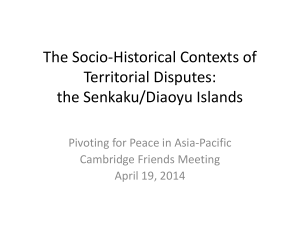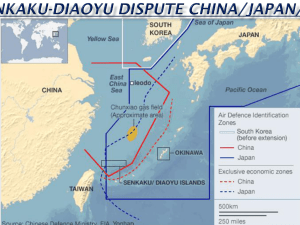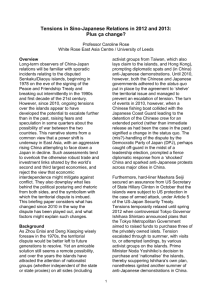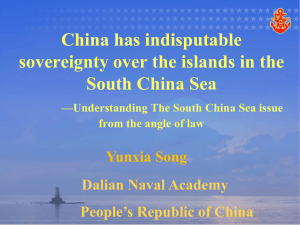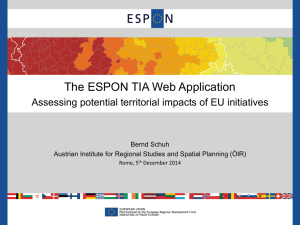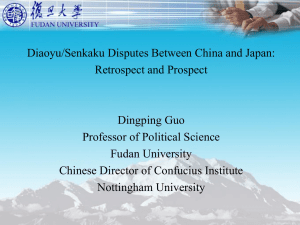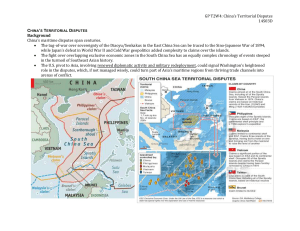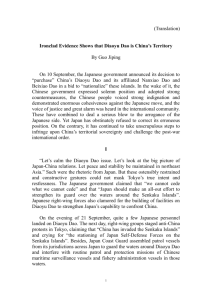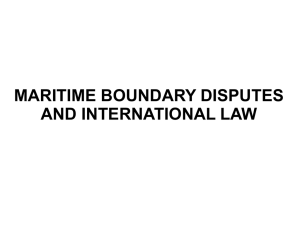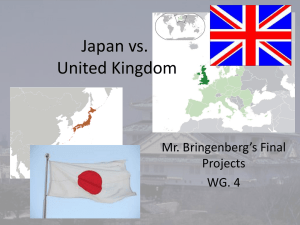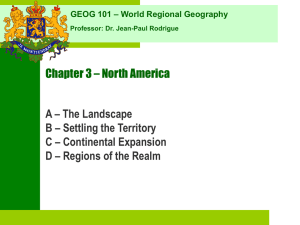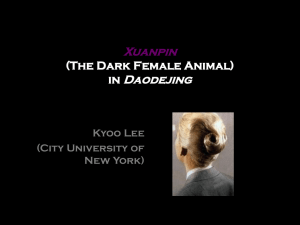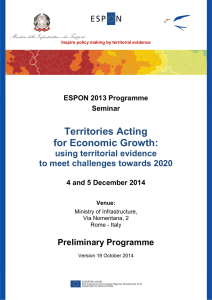Territorial disputes -Sea - Senkaku
advertisement
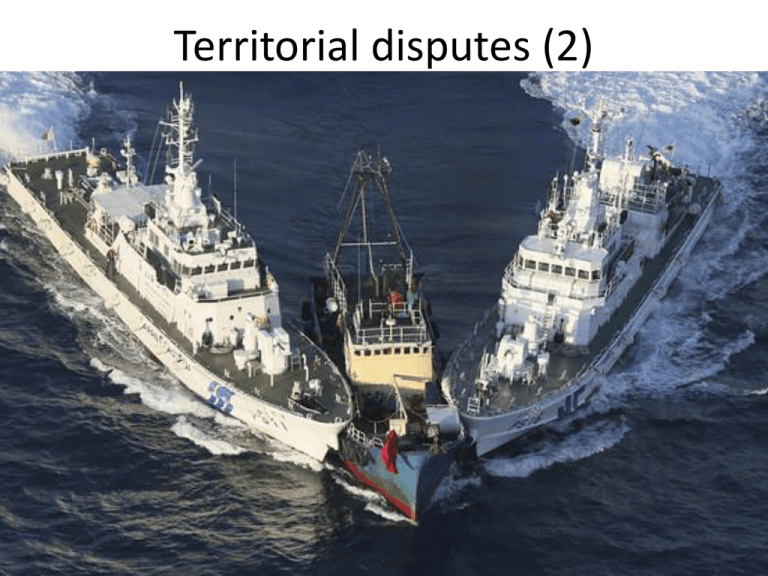
Territorial disputes (2) This class • Maritime Territorial Disputes • Basics on the ‘Law of the Sea’ (1982) • Case study: Senkaku/Diaoyu/Diaoyutai islands • ‘Freedom of-the-seas’ doctrine: sea “free to all and belonging to none”, except for narrow ribbon along the coast (generally 3 miles). • Competition over fishing, pollution, tensions of resource rights, provocative foreign navy presence Challenges to the ‘freedom of the seas” • In 1945, President Harry S Truman, responding in part to pressure from domestic oil interests, unilaterally extended United States jurisdiction over all natural resources on that nation's continental shelf - oil, gas, minerals, etc… Other nations soon followed suit. Challenges to the ‘freedom of the seas” • 1946, Argentina claimed its shelf and the epicontinental sea above it. • Chile and Peru in 1947, and Ecuador in 1950, asserted sovereign rights over a 200mile zone, hoping thereby to limit the access of distantwater fishing fleets and to control the depletion of fish stocks in their adjacent seas. • Indonesia and then the Philippines assert dominion over seas between islands of their archipelago Maritime territorial disputes Maritime disputes can be based on several dimensions: • Land (esp. islands) • Border • Extent (3 miles, 12 miles, 200 miles, continental shelf) • Sea versus Seabed • Use (fishing, minerals, …) Point Roberts United Nations Convention on the Law of the Sea (UNCLOS) • Pre-dated by a series of conventions (‘Geneva conventions of the Sea, 1958) • Negotiated 1973-1982, in force since 1994 EEZ (grey), High Seas (blue) The Canadian Coast Guard vessel Louis S. St-Laurent (front) and the US Coast Guard vessel Healy (back). An aerial view of the Chukchi Borderland from the north, with tracks from 2003, 2004 and 2007 mapping expeditions. Maritime territorial disputes in China Seas Senkaku/Diaoyu/Diaoyutai Islands Brief chronology • Maritime markers • Annexed by Japan in 1895 following ‘First Sino-Japanese War’ • 1951 San Francisco Peace Treaty => area under US control • 1971-72 US ends its control of Okinawa/Ryukus => Japan • 1972 PR China and Taiwan assert sovereignty • 1970s Islands sold to Japanese family, who rents them to Japan government • 2012 Japanese gvt purchase islands from family Politicization • Nationalism • Instrumentalization by political opposition – China: 1990s => anti-reform (e.g. SG Hu Yaobang described as ‘pro-Japan’) – Japan: => far-right ultra-nationalist parties (e.g. Nihon Seinensha pursuing ‘anti-China’ policy) • Perceived need by government to take a ‘hard-line’ position Ministry of Foreign Affairs of Japan “There is no doubt that the Senkaku Islands are clearly an inherent part of the territory of Japan, in light of historical facts and based upon international law. Indeed, the Senkaku Islands are under the valid control of Japan. There exists no issue of territorial sovereignty to be resolved concerning the Senkaku Islands. It was not until 1971, after an academic survey indicated the possibility of the existence of petroleum resources on the surrounding sea in 1968, that the Government of China and Taiwan authorities officially began to make their own assertions about territorial sovereignty of the Senkaku Islands.” http://www.mofa.go.jp/region/asia-paci/senkaku/index.html Ministry of Foreign Affairs of China “Diaoyu Dao and its affiliated islands are an inseparable part of the Chinese territory. Diaoyu Dao is China's inherent territory in all historical, geographical and legal terms, and China enjoys indisputable sovereignty over Diaoyu Dao. Japan's occupation of Diaoyu Dao during the Sino-Japanese War in 1895 is illegal and invalid. Diaoyu Dao has been an inherent territory of China since ancient times, and China has indisputable sovereignty over Diaoyu Dao. … As China and Japan were normalizing relations and concluding the Sino-Japanese Treaty of Peace and Friendship in the 1970s, the then leaders of the two countries, acting in the larger interest of China-Japan relations, reached important understanding and consensus on "leaving the issue of Diaoyu Dao to be resolved later." But in recent years, Japan has repeatedly taken unilateral measures concerning Diaoyu Dao and conducted in particular the so-called "nationalization" of Diaoyu Dao. This severely infringed upon China's sovereignty and ran counter to the understanding and consensus reached between the older generation of leaders of the two countries. It has not only seriously damaged China-Japan relations, but also rejected and challenged the outcomes of the victory of the World Anti-Fascist War. China strongly urges Japan to respect history and international law and immediately stop all actions that undermine China's territorial sovereignty. The Chinese government has the unshakable resolve and will to uphold the nation's territorial sovereignty. It has the confidence and ability to safeguard China's state sovereignty and territorial integrity.” http://www.fmprc.gov.cn/eng/zxxx/t973774.htm Taiwan asserts its own claims Recommendations? Recommendations? • Cautious ‘neglect’ • Bi/Tri-lateral negotiations – Compromise (joint-exploitation of resources) – Local referendum (no ‘local’ population) • Third party arbitration • International judgment • War?! Conclusions • Disputed territories are numerous • Territorial disputes can easily be politicized along nationalistic lines • Territorial disputes can escalate into armed conflict • Geopolitical representations of the issues and territory are important • There are many ways to solve territorial disputes At home … • Check “Canada’s territorial disputes” interactive map http://www.theglobeandmail.com/news/nation al/canadas-territorial-disputes/article5813168/ • What is the main selection criteria here, do you know of other territorial disputes ‘within Canada’? • If interested in International Law aspects of territorial sovereignty and territorial disputes, see (‘Settling Territorial Disputes’ lecture): http://untreaty.un.org/cod/avl/ls/Shaw_BD.html #
